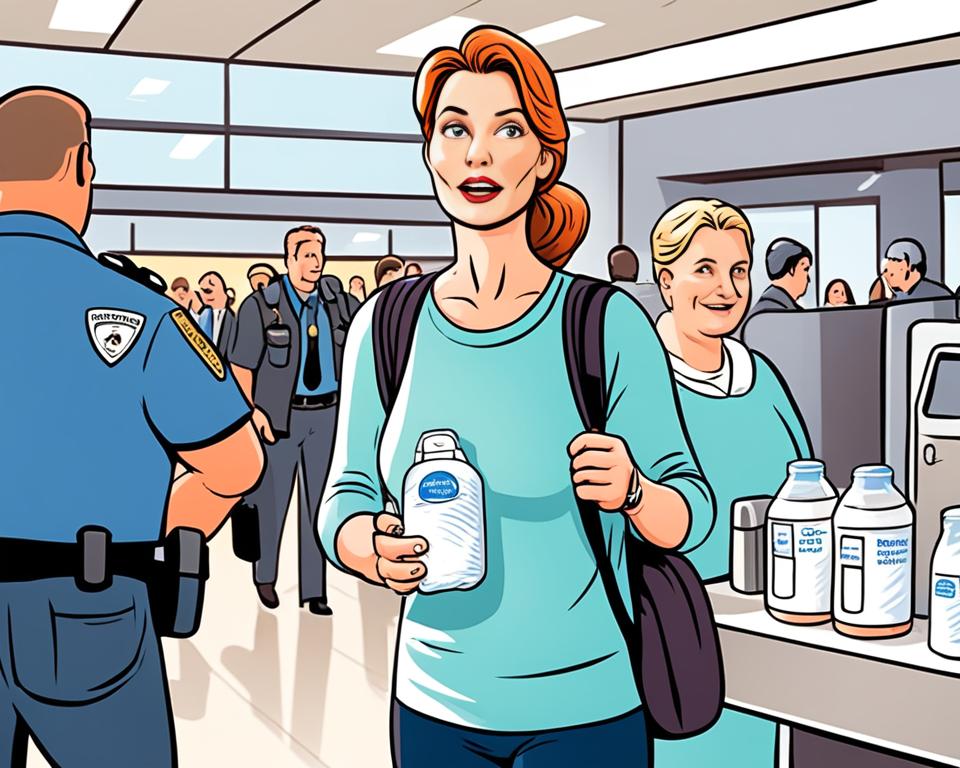Traveling with frozen breast milk can present some unique challenges, but with the right preparation and knowledge, it can be done successfully. Whether you’re a nursing mother who is going on a business trip or a family vacation, knowing how to navigate the guidelines and ensure the safety of your breast milk is essential. In this guide, we will provide you with valuable tips and advice on traveling with frozen breast milk, including information on TSA guidelines, proper packing methods, and keeping the milk cold while on the move.
Key Takeaways:
- Understanding TSA guidelines is crucial for traveling with frozen breast milk
- Using appropriate containers and ensuring proper storage is important for packing breast milk in carry-on luggage
- Investing in an insulated breast milk cooler can help keep the milk cold during travel
- Thawing frozen breast milk safely is essential for preserving its nutrients
- Planning and preparation are key to traveling with frozen breast milk successfully
TSA Guidelines for Traveling with Breast Milk
When it comes to traveling with breast milk, it’s essential to be familiar with the guidelines set by the Transportation Security Administration (TSA). Understanding these guidelines will help ensure a smooth and stress-free journey with your precious liquid gold.
According to TSA guidelines, breast milk is considered a medically necessary liquid and is exempt from the 3-ounce limit for other liquids. This means that you can carry more than 3 ounces of breast milk in both your carry-on and checked luggage within the United States.
Not only can you bring breast milk, but you can also pack accessories such as ice packs and coolers to maintain the temperature of the milk. These accessories are allowed in both carry-on and checked luggage. It’s important to note that the rules regarding breast milk may vary for return flights from other countries. For specific guidelines, it’s always best to check with your airline before you travel.
| Allowed Items | Carry-On | Checked Luggage |
|---|---|---|
| Breast Milk | ✓ | ✓ |
| Ice Packs | ✓ | ✓ |
| Coolers | ✓ | ✓ |
It’s important to pack your breast milk in a way that it remains safe and insulated throughout your journey. Proper storage and packaging will help maintain the quality of your milk. In the next section, we’ll explore the best containers for frozen breast milk and storage guidelines to ensure the optimal condition of your milk during travel.
Packing Breast Milk for Carry-On
When it comes to packing breast milk for carry-on during your travels, it’s crucial to use appropriate containers and follow storage guidelines to ensure the safety and quality of the milk.
Clear, translucent bottles are highly recommended as they can be easily screened by TSA’s Bottle Liquid Scanners. These bottles allow for quick and efficient inspection, making the security process smoother. It’s important to choose bottles that are leak-proof and freezer-safe to prevent any spills or contamination. Glass breast milk storage bottles are an excellent option as they are sturdy and can be stored directly in an insulated breast milk cooler.
Insulated breast milk coolers play a vital role in maintaining the temperature of the milk and keeping it cold during your journey. They help prevent the milk from thawing and ensure optimal freshness. Remember to remove your breast milk containers and coolers from your carry-on bag during the security screening process for separate inspection if required.
Following proper storage guidelines ensures that the breast milk remains safe for consumption. When selecting containers for your frozen breast milk, consider the following:
- Choose clear, translucent bottles for easy inspection
- Opt for leak-proof and freezer-safe containers
- Consider using glass breast milk storage bottles for added durability
By packing your breast milk in appropriate containers and coolers, you can travel with confidence, knowing that your milk will remain safe, properly stored, and ready to nourish your little one.
Keeping Breast Milk Cold While Traveling
When traveling with breast milk, it’s crucial to ensure that it stays cold to maintain its quality and safety. Using an insulated breast milk cooler with ice packs or gel packs is highly recommended, as it helps to keep the milk cold for up to 20 hours. The insulation in the cooler helps to regulate the temperature and prevent any thawing or spoilage of the breast milk.
For optimal performance, it’s important to fill the cooler as full as possible. This maximizes insulation and helps to keep the milk colder for a longer period of time. If there is empty space in the cooler, it can lead to temperature fluctuations and decrease the overall effectiveness of keeping the milk cold.
Another useful tip is to pre-chill the cooler in the freezer before traveling. This helps to further maintain the low temperature inside the cooler and provides an additional layer of insulation. By pre-chilling the cooler, you can extend the period in which the breast milk stays cold, ensuring that it remains safe to use.
Image:
If you’re planning a longer trip and require frozen breast milk, using dry ice can be a great option. Dry ice is extremely cold and can keep the milk frozen throughout the journey. However, it’s important to handle dry ice with caution and follow the necessary guidelines for its usage and transportation.
| Tip | Description |
|---|---|
| Use an insulated breast milk cooler | To maintain the cold temperature of the breast milk |
| Fill the cooler as full as possible | To maximize insulation and keep the milk colder for longer |
| Pre-chill the cooler in the freezer | To provide an additional layer of insulation |
| Consider using dry ice for longer trips | To keep the milk frozen throughout the journey |
By following these guidelines and tips, you can ensure that your breast milk remains cold and safe while traveling. Properly storing and maintaining the temperature of breast milk is crucial for the health and well-being of your baby, allowing you to have peace of mind during your journey.
Thawing Frozen Breast Milk
If you’re traveling with frozen breast milk and need to thaw it, it’s important to do so safely. The best method for thawing frozen breast milk is to place it in the refrigerator overnight. Avoid thawing breast milk at room temperature or using hot water, as it can destroy the important nutrients in the milk. Once thawed, the breast milk should be used within 24 hours and should not be refrozen.
| Thawing Methods | Pros | Cons |
|---|---|---|
| Refrigerator Thawing |
|
|
| Room Temperature Thawing |
|
|
| Hot Water Thawing |
|
|
Conclusion
Traveling with breast milk requires careful planning and preparation to ensure the safety and quality of your milk. By following the guidelines set by the Transportation Security Administration (TSA), using proper containers, and keeping the milk cold during transportation, you can confidently travel with frozen breast milk.
When packing breast milk for carry-on, opt for clear and leak-proof containers that meet TSA guidelines. Using insulated breast milk coolers with ice packs or gel packs will help keep the milk cold for up to 20 hours. Remember to fill the cooler as full as possible and pre-chill it in the freezer before traveling for maximum insulation.
Thawing frozen breast milk should be done safely by placing it in the refrigerator overnight. Avoid thawing at room temperature or using hot water, as it can compromise the nutrients in the milk. Once thawed, the breast milk should be used within 24 hours and should not be refrozen.
With these tips and guidelines, you can travel with frozen breast milk confidently, knowing that you have taken the necessary precautions to ensure the safety and quality of your milk. Happy travels!
FAQ
What are the TSA guidelines for traveling with breast milk?
The Transportation Security Administration (TSA) allows passengers to carry breast milk in both carry-on and checked luggage within the United States. Breast milk is considered a medically necessary liquid and is exempt from the 3-ounce limit for other liquids. Accessories such as ice packs and coolers are also allowed. It’s recommended to check with the airline for specific guidelines on return flights from other countries.
What containers should I use when packing breast milk for carry-on?
Clear, translucent bottles are recommended as they can be easily screened by TSA’s Bottle Liquid Scanners. It’s best to use leak-proof and freezer-safe containers to prevent spills and maintain the quality of the milk. Glass breast milk storage bottles are a good option, as they can be stored directly in an insulated breast milk cooler. Remember to remove these items from your carry-on for separate screening.
How can I keep breast milk cold while traveling?
It’s recommended to use an insulated breast milk cooler with ice packs or gel packs to keep the milk cold for up to 20 hours. Fill the cooler as full as possible to maximize insulation. Pre-chilling the cooler in the freezer before traveling can also help. If the trip is longer and requires frozen breast milk, using dry ice in a packed cooler can keep the milk frozen throughout the journey.
What is the best method for thawing frozen breast milk?
The best method for thawing frozen breast milk is to place it in the refrigerator overnight. Avoid thawing breast milk at room temperature or using hot water, as it can destroy the important nutrients in the milk. Once thawed, the breast milk should be used within 24 hours and should not be refrozen.


